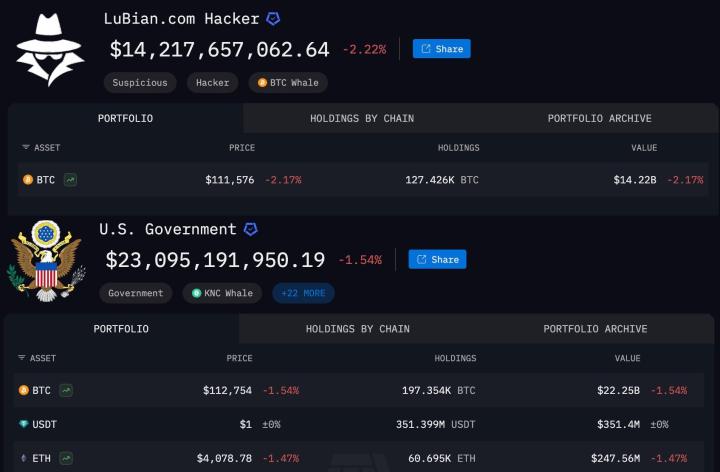For the past three days, the price of Bitcoin seems to want to break below the support set around $110,000.
Will there be another crash?
This hypothesis indeed seems at least plausible, but there is at least one element that suggests the opposite hypothesis might actually be true.
Summary
The Bitcoin Crash
Monday, October 6, 2025, the price of Bitcoinmarked a new all-time high, rising above $126,000.
Already the next day, however, it had dropped below $121,000, even if only momentarily.
Thursday the 9th not only had it fallen back below $121,000, but it also ended up touching $119,000, albeit only momentarily.
On Friday the 10th, however, there was a real crash.
However, it was a crash divided into two distinct moments.
The first one, lasting just over six hours, was characterized by massive forced liquidations of long positions. When long positions are forcibly liquidated, the underlying is instantly sold at market price, increasing the selling pressure.
The crash last Friday was of such magnitude that the selling pressure literally skyrocketed, so much so that the price of BTC dropped well below $110,000, starting from around $121,000.
As soon as that initial phase characterized primarily by sales generated from the forced liquidations of leveraged long positions was over, the price of Bitcoin immediately bounced back above $114,000, but it was an ephemeral rebound.
If nothing else, however, that rebound initiated the second phase, which is still ongoing, characterized instead by volatile lateralization precisely between $110,000 and $115,000.
In the world of cryptocurrency, the market sentiment often swings between bull and bear phases. Understanding these trends is crucial for investors looking to maximize their returns. During a bull market, prices are generally rising, and investor confidence is high. Conversely, a bear market is characterized by falling prices and a lack of confidence among investors. Staying informed about the latest market trends and price movements is essential for making strategic investment decisions. Utilizing tools like the TradingView widget can provide real-time data and insights into market dynamics, helping investors to navigate the volatile crypto landscape effectively.
The Key Threshold
At this moment, therefore, the key threshold seems to be $110,000.
To tell the truth, on Saturday 11th and Sunday 12th that threshold was breached on the downside, but these were really minor breaches, and of very short duration. In the following days, however, it has always held, at least for now.
In particular, starting from yesterday, there have been three attempts to break it downwards, and a fourth might be underway today.
It is not certain that this threshold must necessarily hold, but a deep and lasting breach of it could simply end the lateralization period that began after the post-crash rebound.
Gold
At this moment, the real issue seems to be the gold market.
Indeed, starting from Monday, a mini-speculative bubble seems to have inflated on the gold price, particularly with the abundant surpassing of the $4,000 per ounce mark.
It is possible that this mini-bubble, in order to sustain itself, is also draining capital from other markets, and one of these should be the Bitcoin market.
Therefore, a gold price that remains very high (now above $4,200 per ounce) actually prevents the price of Bitcoin from recovering, and indeed seriously risks pushing it below $110,000, thus ending the lateralization period of recent days.
However, speculative bubbles are always destined to burst sooner or later. At this moment, it is not 100% confirmed that a mini-speculative bubble on gold has formed starting from Monday, but it actually seems quite difficult to maintain prices above $4,200 per ounce for long.
It is not even possible to predict when this mini-bubble might burst, although in theory it seems unlikely that it could remain intact until next Monday or Tuesday.
In the event of a breakout, there would be capital outflows from the gold market, which could partially flow into the Bitcoin market.
The Dollar Index
The fact is that for some days now the Dollar Index has been weakening.
Tuesday was at 99.4 points, but already yesterday it had fallen below 99 points. Today it even dropped below 98.5 points, only to rise back above 98.6.
In general, the trend of the Bitcoin price tends to be inversely correlated with that of the Dollar Index in the medium term, therefore this recent decline could theoretically end up being favorable to BTC, in the event that the mini-bubble on gold bursts.
Furthermore, it is very likely that the trigger for the decline on October 7 was precisely the upward break of the key threshold of 97.7 points of the Dollar Index, therefore a trend reversal of the DXYbullish trend could have positive effects on the price of BTC even in the short term, at least in theory.
In the ever-evolving world of cryptocurrency, understanding market trends is crucial for investors. The terms “bull” and “bear” markets are frequently used to describe the general direction of the market. A “bull” market indicates a period of rising prices, while a “bear” market signifies declining prices. Investors often look for signals to determine whether the market is in a “bull” or “bear” phase to make informed decisions. Cryptocurrency markets are known for their volatility, with prices capable of significant swings in short periods. This volatility can present both opportunities and risks for traders. Technical analysis tools, such as candlestick charts, are commonly used to analyze price movements and identify potential trends. The DXY index, which measures the value of the US dollar against a basket of foreign currencies, can also influence cryptocurrency prices. A strong dollar may lead to lower cryptocurrency prices, while a weaker dollar could boost them. Therefore, keeping an eye on the DXY index can provide valuable insights for cryptocurrency investors. In conclusion, staying informed about market trends and utilizing technical analysis can help investors navigate the complexities of the cryptocurrency market. Whether in a “bull” or “bear” market, understanding these dynamics is essential for making strategic investment decisions.
Is a new crash coming for Bitcoin (BTC)?
All this leads to say that, in the event that the mini-bubble on gold does not burst, and the support set at $110,000 is broken to the downside, the price of Bitcoin could face a new crash, or at least a new decline.
In the absence of large forced liquidations of leveraged long positions, it might just be a normal dip; otherwise, it could again be a crash similar to last Friday’s.
However, if the mini-bubble on gold were to burst, there should be the conditions for a rebound in the price of BTC.
The point is that it is not truly predictable when any mini-bubble will burst, therefore it is effectively impossible to state which of the two scenarios is actually the most likely.







